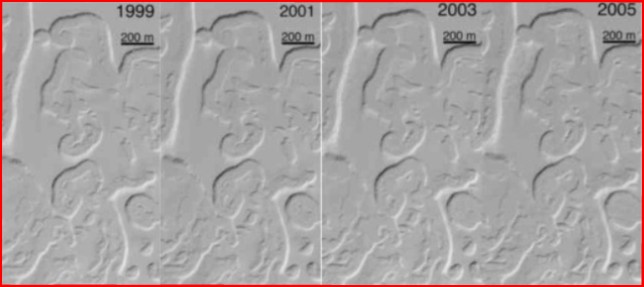
home •
about •
essential guide •
picture of the day •
thunderblogs •
news •
multimedia •
predictions •
products •
get involved •
contact
picture of the day archive subject index
Credit: NASA/JPL/MSSS
(The picture has been converted to negative to help visualization of relief)
May 02, 2006
Warm Ice Caps and Warmed-over IdeasThough today’s theoretical frameworks have encouraged impressive technical feats, they continually discourage scientific discovery. Spectacular images and data from space are a mark of technical proficiency, but a larger field of theoretical possibilities can no longer be ignored.
The caption to this sequence of time-lapse images of trenches on Mars’ south polar cap explains:
“Each year that Mars Global Surveyor has been in orbit, the landforms of the south polar residual cap have gotten smaller, and the carbon dioxide removed from the cap has not been re-deposited. The implication is that Mars presently has a warm (and possibly warming) climate, with new carbon dioxide going into the atmosphere every year. The other implication is that, at some time in the not-too-distant past, the planet had a colder climate, so that the layers of carbon dioxide could be deposited in the first place. If one takes the rate of scarp retreat and projects it backwards to fill in all of the pits and troughs with the carbon dioxide that has been removed from them, one finds that the colder climate might only have occurred a few centuries to a few tens of thousands of years ago. This kind of time scale is not unlike that of the climate changes that have been recorded on Earth....”
That the trenches are getting wider because Mars is getting warmer is a familiar assumption. That an increase in carbon dioxide will cause an increase in climatic temperature is another familiar assumption. The trouble with familiar assumptions is that they seem too true to doubt.
Mars may well be getting warmer, but the first assumption ignores the unfamiliar discovery that plasma is prevalent in the solar system and that it has extensive electrical properties. What else besides global warming might widen the trenches? We’ve mentioned the electrical connection in previous Pictures of the Day.
And Mars may well be getting more carbon dioxide in its thin atmosphere, but the second assumption ignores the unfamiliar discovery that trapping heat in an atmosphere requires stopping convection, as with the glass in a greenhouse, rather than increasing the opacity of the air (which is the effect of increasing carbon dioxide).
Familiar assumptions are useful. They allow you to get on with your daily routine. If you questioned every assumption, you wouldn’t be able to tie your shoelaces in the morning. “We already have an explanation” is the motto of the technician, whose goal is to accomplish the task at hand.
Science is not—or at least should not be—technique. The goal of science is not apply in different ways what has already been discovered but to discover something new. The motto of the scientist should be “What else could it be?”
A number of critics—the late Fred Hoyle among them—have noticed and lamented that the technical success and fecundity of the space programs have been at the expense of scientific discovery. Compared with the wide-ranging thought of prior times, the Age of NASA has brought a culture of conformity to science, a monoculture of theory that, like a genetically engineered cornfield, has killed off all the weeds. What is good (or at least efficient) for a cornfield marks the end of science and the beginning of a pseudo-religion of One Truth.
Space-age images and data have consistently contradicted technical expectations. Yet the scientific reports and analyses stand out in their non-scientific failure to ask “What else could it be?” Taking plasma into account, it could be something else entirely.
Mars’ plasma sheath appears to connect directly to the surface with many small, filamentary Birkeland currents in the dark discharge mode. The condition is similar to that of Jupiter's moon Io but at a lower power level. Miles-high dust devils—electric vortices—scorch the landscape. Lichtenberg patterns, characteristic of lightning strikes, appear burned into the soil around new craters. In this view, the widening of the polar trenches is an expected feature of cathode sputtering, which occurs around the edges of circular depressions and other prominent relief being etched by electrical discharge machining.
Another intriguing “what else” arises in response to the “retrocalculation” that the erosion of the ice cap may have begun only “a few centuries to a few tens of thousands of years ago.” This time span is similar to that estimated for the occurrence of the plasma instabilities around Earth that were recorded in petroglyphs. In view of the ancient testimony connecting Mars to such a time of instability, the “global warming” of both Earth and Mars may stem from the same interplanetary event.
__________________________________________________________________________Please visit our new "Thunderblog" page
Through the initiative of managing editor Dave Smith, we’ve begun the launch of a new
page called Thunderblog. Timely presentations of fact and opinion, with emphasis on
new discoveries and the explanatory power of the Electric Universe."The Electric Sky and The Electric Universe available now!

|
|

|
EXECUTIVE EDITORS:
David Talbott, Wallace Thornhill
MANAGING EDITOR:
Michael Armstrong
CONTRIBUTING EDITORS: Dwardu Cardona, Ev Cochrane,
C.J. Ransom, Don Scott, Rens van der Sluijs, Ian Tresman
WEBMASTER: Michael Armstrong
Copyright 2006: thunderbolts.info
![]()
home •
thunderblogs •
forum •
picture of the day •
resources •
team •
updates •
contact us

